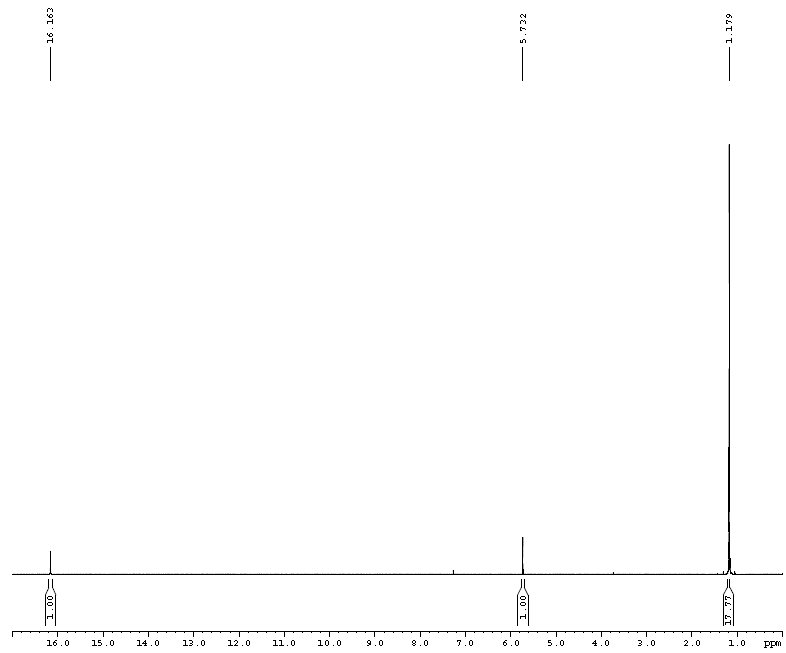2,2,6,6-Tetramethyl-3,5-heptanedione CAS#: 1118-71-4; ChemWhat Code: 1405289
Identification
| Product Name | 2,2,6,6-Tetramethyl-3,5-heptanedione |
| IUPAC Name | 2,2,6,6-tetramethylheptane-3,5-dione |
| Molecular Structure |  |
| CAS Registry Number | 1118-71-4 |
| EINECS Number | 214-268-3 |
| MDL Number | MFCD00008848 |
| Beilstein Registry Number | 1447269 |
| Synonyms | 2,2,6,6-tetramethylheptane-3,5-dione, 2,2,6,6-tetramethyl-3,5-heptanedione, dipivaloylmethane, 2,2,6,6-tetramethylheptan-3,5-dione |
| Molecular Formula | (CH3)3CCOCH2COC(CH3)3 |
| Molecular Weight | 184.28 |
| InChI | InChI=1S/C11H20O2/c1-10(2,3)8(12)7-9(13)11(4,5)6/h7H2,1-6H3 |
| InChI Key | YRAJNWYBUCUFBD-UHFFFAOYSA-N |
| Canonical SMILES | CC(C)(C)C(=O)CC(=O)C(C)(C)C |
| Patent Information | ||
| Patent ID | Title | Publication Date |
| CN112759617 | Iridium-coordinated organic electroluminescent material and preparation method and application thereof | 2021 |
Physical Data
| Appearance | Light yellow liquid |
| Solubility | No data available |
| Flash Point | No data available |
| Refractive index | No data available |
| Sensitivity | No data available |
| Melting Point, °C |
| 28 – 30 |
| 25 |
| Boiling Point, °C | Pressure (Boiling Point), Torr |
| 96 – 98 | 20 |
| 56 – 58 | 3 |
| 83 – 86 | 6 – 10 |
| 86 | 22 |
| 102 | 31 |
| Refractive Index | Wavelength (Refractive Index), nm | Temperature (Refractive Index), °C |
| 1.457 | 589 | 25 |
| 1.4566 | 589 | 25 |
| 1.4572 | 589 | 25 |
| Description (Association (MCS)) |
| Spectrum of the complex |
| Stability constant of the complex with … |
| Enthalpy of association |
| NMR spectrum of the complex |
Spectra
| Description (NMR Spectroscopy) | Nucleus (NMR Spectroscopy) | Solvents (NMR Spectroscopy) | Temperature (NMR Spectroscopy), °C | Frequency (NMR Spectroscopy), MHz |
| Chemical shifts, Spectrum | 1H | chloroform-d1 | 500 | |
| Chemical shifts, Spectrum | 13C | chloroform-d1 | 125 | |
| Chemical shifts | 17O | 22 | 81.4 | |
| Chemical shifts, Spectrum | 1H | d7-N,N-dimethylformamide | 300 | |
| Chemical shifts | 1H | chloroform-d1 | 400 | |
| Chemical shifts | 1H | CDCl3 | 400 |
| Description (IR Spectroscopy) | Solvent (IR Spectroscopy) | Comment (IR Spectroscopy) |
| ATR (attenuated total reflectance), Bands, Spectrum | ||
| Spectrum | ||
| Bands,Spectrum | tetrachloromethane | |
| Bands,Spectrum | neat liquid | |
| Bands | KBr | |
| Bands | CHCl3 | 3590 – 1600 cm**(-1) |
| IR |
| Description (Mass Spectrometry) |
| high resolution mass spectrometry (HRMS), electrospray ionisation (ESI), time-of-flight mass spectra (TOFMS), spectrum |
| Description (UV/VIS Spectroscopy) | Solvent (UV/VIS Spectroscopy) | Absorption Maxima (UV/VIS), nm | Ext./Abs. Coefficient, l·mol-1cm-1 |
| Spectrum | ethanol | ||
| Spectrum | dichloromethane | ||
| Absorption maxima | ethanol | 294 | 22000 |
| UV/VIS | |||
| Absorption maxima | 2,2,4-trimethyl-pentane |
Route of Synthesis (ROS)
| Conditions | Yield |
| With N-Bromosuccinimide In tetrachloromethane for 2h; Heating / reflux; | 100% |
| With N-Bromosuccinimide In tetrachloromethane for 2h; Heating / reflux; | 100% |
| With N-Bromosuccinimide In tetrachloromethane for 2h; Heating / reflux; | 100% |
Safety and Hazards
| Pictogram(s) |  |
| Signal | Warning |
| GHS Hazard Statements | H302 (93.02%): Harmful if swallowed [Warning Acute toxicity, oral] H315 (11.63%): Causes skin irritation [Warning Skin corrosion/irritation] H319 (11.63%): Causes serious eye irritation [Warning Serious eye damage/eye irritation] H335 (11.63%): May cause respiratory irritation [Warning Specific target organ toxicity, single exposure; Respiratory tract irritation] Information may vary between notifications depending on impurities, additives, and other factors. |
| Precautionary Statement Codes | P261, P264, P270, P271, P280, P301+P312, P302+P352, P304+P340, P305+P351+P338, P312, P321, P330, P332+P313, P337+P313, P362, P403+P233, P405, and P501 (The corresponding statement to each P-code can be found at the GHS Classification page.) |
Other Data
| Transportation | Not Classified |
| Under the room temperature and away from light | |
| HS Code | No data available |
| Storage | Store at 2-8℃ for long time, sealed and away from light. |
| Shelf Life | 2 years |
| Market Price | USD |
| Druglikeness | |
| Lipinski rules component | |
| Molecular Weight | 184.279 |
| logP | 1.725 |
| HBA | 2 |
| HBD | 0 |
| Matching Lipinski Rules | 4 |
| Veber rules component | |
| Polar Surface Area (PSA) | 34.14 |
| Rotatable Bond (RotB) | 4 |
| Matching Veber Rules | 2 |
| Use Pattern |
| 2,2,6,6-Tetramethyl-3,5-heptanedione CAS#: 1118-71-4 can be used as a catalyst for a variety of organic synthesis reactions |
| 2,2,6,6-Tetramethyl-3,5-heptanedione CAS#: 1118-71-4 also be widely used as a MOCVD precursor to further prepare semiconductor materials such as precious metal films. |
| 2,2,6,6-Tetramethyl-3,5-heptanedione CAS#: 1118-71-4 as a agent for remedying deterioration of insulating film |
Buy Reagent | |
| No reagent supplier? | Send quick inquiry to ChemWhat |
| Want to be listed here as a reagent supplier? (Paid service) | Click here to contact ChemWhat |
Approved Manufacturers | |
| Warshel Chemical Ltd | http://www.warshel.com/ |
| Want to be listed as an approved manufacturer (Requires approvement)? | Please download and fill out this form and send back to approved-manufacturers@chemwhat.com |
Contact Us for Other Help | |
| Contact us for other information or services | Click here to contact ChemWhat |


